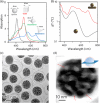Plasmonic Nanostructures for Photothermal Conversion
- PMID: 40212468
- PMCID: PMC11935886
- DOI: 10.1002/smsc.202000055
Plasmonic Nanostructures for Photothermal Conversion
Abstract
The nonradiative conversion of light to heat by plasmonic nanostructures, the so-called plasmonic photothermal effect, has attracted enormous attention due to their widespread potential applications. Herein, the perspectives on the design and preparation of plasmonic nanostructures for light to heat or photothermal conversion are provided. The general principle of plasmonic photothermal conversion is first introduced, and then, the strategies for improving efficiency are discussed, which is the focus of this field. Then, five typical application types are used, including solar energy harvesting, photothermal actuation, photothermal therapy, laser-induced color printing, and high-temperature photothermal devices, to elucidate how to tailor the nanomaterials to meet the requirements of these specific applications. In addition to the photothermal effect, other unique physical and chemical properties are coupled to further explore the application scenarios of plasmonic photothermal materials. Finally, a summary and the perspectives on the directions that may lead to the future development of this exciting field are also given.
Keywords: light to heat; photoactuation; photothermal conversion; photothermal therapy; plasmonic; solar energy harvesting.
© 2021 The Authors. Small Science published by Wiley‐VCH GmbH.
Conflict of interest statement
The authors declare no conflict of interest.
Figures










Similar articles
-
Nanostructured Photothermal Materials for Environmental and Catalytic Applications.Molecules. 2021 Dec 13;26(24):7552. doi: 10.3390/molecules26247552. Molecules. 2021. PMID: 34946627 Free PMC article. Review.
-
Advances in photothermal nanomaterials for biomedical, environmental and energy applications.Nanoscale. 2021 Sep 2;13(34):14268-14286. doi: 10.1039/d1nr04197e. Nanoscale. 2021. PMID: 34473186 Review.
-
Photonic-Plasmonic Nanostructures for Solar Energy Utilization and Emerging Biosensors.Nanomaterials (Basel). 2020 Nov 12;10(11):2248. doi: 10.3390/nano10112248. Nanomaterials (Basel). 2020. PMID: 33198391 Free PMC article. Review.
-
Plasmonic nanotechnology for photothermal applications - an evaluation.Beilstein J Nanotechnol. 2023 Mar 27;14:380-419. doi: 10.3762/bjnano.14.33. eCollection 2023. Beilstein J Nanotechnol. 2023. PMID: 37025366 Free PMC article. Review.
-
Supra-Photothermal CO2 Methanation over Greenhouse-Like Plasmonic Superstructures of Ultrasmall Cobalt Nanoparticles.Adv Mater. 2024 Mar;36(9):e2308859. doi: 10.1002/adma.202308859. Epub 2023 Dec 14. Adv Mater. 2024. PMID: 37931240
Cited by
-
Lignin-Based Photothermal Materials: Bridging Sustainability and High-Efficiency Energy Conversion.Adv Sci (Weinh). 2025 May;12(20):e2501259. doi: 10.1002/advs.202501259. Epub 2025 Apr 25. Adv Sci (Weinh). 2025. PMID: 40279516 Free PMC article. Review.
-
Photothermally Driven Ultrafast Polymerase Chain Reaction: Mechanisms, Nanomaterial Architectures, and System Integration.Research (Wash D C). 2025 Aug 15;8:0839. doi: 10.34133/research.0839. eCollection 2025. Research (Wash D C). 2025. PMID: 40822125 Free PMC article. Review.
-
Superior photothermal conversion performance of black titanium-based materials.iScience. 2025 Mar 10;28(4):112188. doi: 10.1016/j.isci.2025.112188. eCollection 2025 Apr 18. iScience. 2025. PMID: 40224008 Free PMC article.
-
Plasmonic Nanomaterials for Versatile Solar Energy Conversion Applications.ACS Omega. 2025 Jul 7;10(27):28615-28629. doi: 10.1021/acsomega.5c02075. eCollection 2025 Jul 15. ACS Omega. 2025. PMID: 40687009 Free PMC article. Review.
-
Nanomaterials in PCR: exploring light-to-heat conversion mechanisms and microfluidic integration.Microsyst Nanoeng. 2025 Jun 19;11(1):127. doi: 10.1038/s41378-025-00898-3. Microsyst Nanoeng. 2025. PMID: 40533488 Free PMC article. Review.
References
-
- Gao M., Zhu L., Peh C. K., Ho G. W., Energy Environ. Sci. 2019, 12, 841.
-
- Qiu J., Xie M., Wu T., Qin D., Xia Y., Chem. Sci. 2021, 11, 12955.
-
- Zeng J., Zhang Y. L., Zeng T., Aleisa R., Qiu Z., Chen Y., Huang J., Wang D., Yan Z., Yin Y., Nano Today 2020, 32, 100855.
-
- Zhang L., Sha X., Fan Q., Han L., Yin Y., Gao C., Nanoscale 2017, 9, 17037. - PubMed
-
- Lim W., Gao Z., Nano Today 2016, 11, 168.
LinkOut - more resources
Full Text Sources
